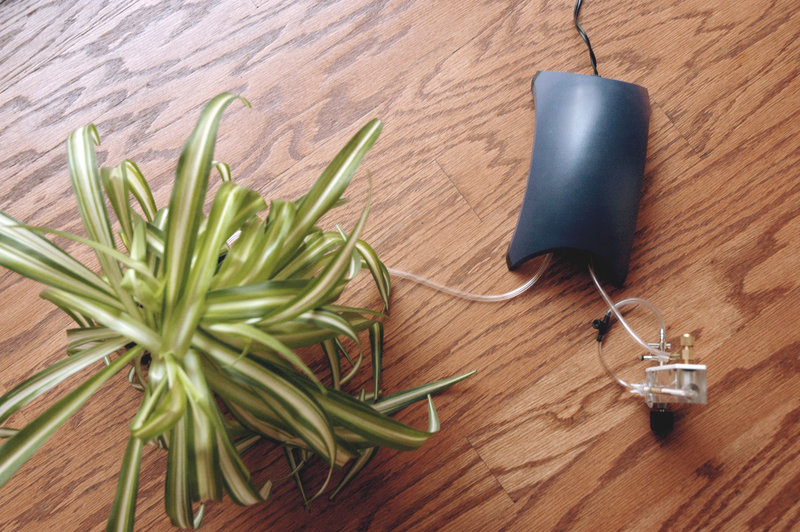
DIY Indoor Air Remediation Kit
The rhyzo-remediatior, bubbles air through plant roots growing in water and rocks, to try to improve indoor air quality. It's an evolving Do-It-Yourself design using commonly available plants and an aquarium pump.
(Lead image is a design sketch by @cguerin from this post)
Related work
A similar $230 system made by a for profit company (at PlantAirPurifier.com) claims that it can clean a 10'x14' room in an hour. Some interior-landscaping industries suggest 1 regular plant on its own (which could be 200 times less efficient than the Public Lab prototype) per 100 sq feet.
Critics say its more like 45 regular plants per 100 feet (surprise! you live in a greenhouse now!) so that would be 680 plants in a 1500 sq foot house. But if our system lives up to the theory you could have just three planters to maintain clean air across your home or one in your bedroom or one in the office.
Also see the BioBroth Bubbler -- an alternate design for bubbling air through a bacterial solution, and this earlier plant filter prototype which predates this work.
Field tests
In the first field test of our remediation tool we found a 40% reduction of formaldehyde in a two bedroom trailer with a single planter. In the second field test we found and an 84% decrease in a conventional two bedroom home.
Activities
| Purpose | Category | Status | Author | Time | Difficulty | Replications |
|---|---|---|---|---|---|---|
| Build a plant-based air purifier | build | in-progress | @nshapiro | 3h | easy | 6 replications: Try it » |
| Building Snake Plant Air Remediation kit in Bangalore, India | build | in-progress | @deeptalaxmibharadwaj | 3h | easy | 0 replications: Try it » |
Activities should include a materials list, costs and a step-by-step guide to construction with photos. Learn what makes a good activity here.
Prototypes
[tag:plant-air-purifier-prototypes]
Questions
| Title | Author | Updated | Likes | Comments |
|---|---|---|---|---|
| What are health and environmental concerns for sewage smell in a home? | @stevie | about 3 years ago | 1 | 3 |
| What kinds of toxins can be filtered by plants, and how do we know? | @warren | over 7 years ago | 0 | 3 |
| In the plant based air purifier, could airflow go the other way, using an unmodified pump? | @warren | over 8 years ago | 1 | 9 |
| How can i know if my plant-based air filter is working? | @liz | over 8 years ago | 2 | 5 |
Remediation
Domestic chemical ecologies have both many toxicant sources and many toxicant sinks. Formaldehyde slowly and silently off gasses from engineered woods, carpets, and permanent press clothing. Some of these silent emissions waft out open windows. Others are absorbed by human bodies or the bodies of companion species. Others still are metabolized by decorative indoor plants and the microbes that inhabit their roots.
Since the 1990s we have been hearing promises of plant-based air filters. See, for example, this patent filed in 1993. Some critics (see this 2009 critical review) find fault in the claim that plants-on-their-own can clean indoor air and state that the average home would need 680 plants to adequately scrub the air of toxicants.
Airflow
Research indicates that it is not so much that different plants remediate the air differently, but that different plants cultivate different rhizospheric conditions by their root exudates and root autolysis. Plants with quantitatively more bacteria dwelling in their rhizosphere won’t remediate as much atmospheric formaldehyde as plants with fewer overall microorganisms amongst their roots but more gram-negative rods.
The formaldehyde removal capacity of plants and their bacterial companion species increases as exposures increase, and over time the bacteria appear to “acquire an increased taste” for exposed toxicants and up-regulate their metabolism. Phyto-bio remediation does not appear to be reaction-limited but diffusion-limited. The amount of air breezing through the roots and across the leaves of indoor plants is minimal.
Increasing Airflow
The Public Lab DIY Indoor Air Remediation Kit builds upon these observations that, at least in theory, increasing the airflow through the root system could increase the remediation capacity of plants by upwards of 200 fold. Plant air scrubbers would not require the intermittent replacement replacement of filters but would become more efficient overtime.
Plants manage decomposition underground by providing sugars to symbiotic and beneficial fungi and bacteria in order to manage root growth and decomposition. Plants spend more energy below ground than above ground, and seasonally grow and kill roots just like leaves. We're piggy backing on this process, using plant-managed colonies of beneficial bacteria to scrub formaldehyde, a naturally occurring product of decomposition.
While there is evidence on both sides to indicate either the efficacy or inefficacy of plants-on-their-own as indoor air filters, there have been no published studies on the efficacy of plant systems with increased airflow, like the prototype offered by Public Lab.


